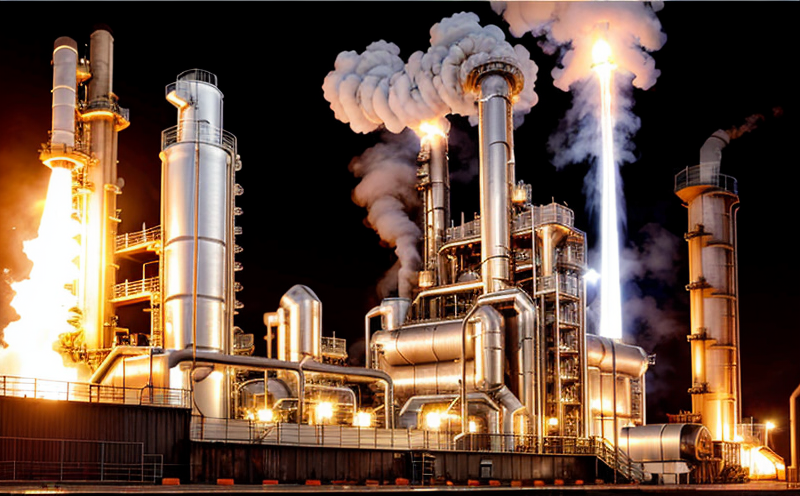Engine Oil Oxidation Stability Test
The Engine Oil Oxidation Stability Test is a critical process control tool used in metallurgy and material testing to monitor the stability of engine oils under high-temperature conditions. This test plays a pivotal role in ensuring that lubricants remain effective over extended operational periods, thereby enhancing both performance and longevity.
In this test, samples are subjected to controlled oxidative stress at elevated temperatures and pressures. The primary objective is to simulate real-world engine operating conditions and assess the oil's resistance to oxidation. Oxidation can lead to a reduction in lubricant quality, increased viscosity, and the formation of sludge and varnish, all of which negatively impact engine performance.
The test is conducted using specialized equipment capable of maintaining precise temperature and pressure settings. Samples are typically exposed to oxygen-rich environments for extended periods, allowing researchers to monitor changes in oil properties over time. Key parameters measured include viscosity, acidity levels, color change, and the formation of insoluble compounds such as sludge.
The test results provide valuable insights into the stability and quality of engine oils under various operational conditions. This information is crucial for quality managers, compliance officers, R&D engineers, and procurement teams responsible for selecting and approving lubricants that meet stringent performance requirements.
Compliance with international standards like ISO 6875-1 ensures consistency and reliability in test results, which are essential for meeting regulatory and industry specifications. The test also aids in optimizing production processes to enhance oil quality and extend product life cycles.
The Engine Oil Oxidation Stability Test is particularly important in sectors where engine performance and longevity are critical, such as automotive manufacturing, aerospace, and heavy-duty equipment operations. By identifying potential issues early on, manufacturers can implement corrective measures, ensuring that their products meet the highest standards of reliability and efficiency.
Real-world applications of this test include the development of new lubricant formulations, quality assurance during production, and field testing to ensure compatibility with existing engine systems. The ability to predict and mitigate oxidation issues translates into significant cost savings through reduced maintenance needs and extended equipment life.
- Customer Impact and Satisfaction:
- Enhanced product reliability leading to increased customer trust.
- Faster identification of potential quality issues, reducing downtime and repair costs.
- Improved operational efficiency by optimizing lubricant performance in engines.
The Engine Oil Oxidation Stability Test is a cornerstone in the metallurgy and material testing industry, offering precise insights into the stability of engine oils. By incorporating this test into their quality control processes, manufacturers can ensure that their products meet strict standards, thereby enhancing both performance and longevity.
Customer Impact and Satisfaction
- Enhanced product reliability leading to increased customer trust:
- Customers receive lubricants that perform consistently over time, reducing the risk of unexpected failures.
- Increased confidence in the brand's ability to deliver high-quality products.
- Proactive identification allows for timely interventions, minimizing operational disruptions.
- Reduction in maintenance costs due to early detection and resolution of problems.
The Engine Oil Oxidation Stability Test is a vital tool that contributes significantly to customer satisfaction by ensuring high-quality lubricants. This test helps manufacturers maintain consistent product performance, leading to increased trust and loyalty among customers.
International Acceptance and Recognition
- Affirmation of the Test's Reliability:
- The Engine Oil Oxidation Stability Test is recognized globally for its reliability in assessing lubricant stability.
- Compliance with ISO 6875-1 ensures that test results are accepted across international borders, facilitating global trade and collaboration.
- The use of this test is standardized in many countries, ensuring that lubricant quality is consistently assessed worldwide.
- Recognition by international regulatory bodies adds credibility to the results, enhancing the trustworthiness of the testing process.
The Engine Oil Oxidation Stability Test enjoys widespread acceptance and recognition within the metallurgy and material testing industry. Its reliability and standardization make it a cornerstone in ensuring consistent lubricant quality across global markets.
Competitive Advantage and Market Impact
The Engine Oil Oxidation Stability Test provides manufacturers with a significant competitive advantage by ensuring that their products meet the highest standards of performance and reliability. In today's fast-paced market, where consumer expectations are continually rising, this test is essential for maintaining a strong brand reputation.
By offering lubricants that demonstrate superior oxidation stability, manufacturers can differentiate themselves from competitors, attracting customers seeking reliable and high-quality products. This competitive edge translates into increased market share and customer loyalty.
The ability to predict and mitigate oxidation issues through this test also leads to reduced maintenance costs and extended equipment life. These cost savings are passed on to consumers, further enhancing the value proposition of the product. In an increasingly cost-conscious market, this added value can be a decisive factor in winning customers.
Moreover, compliance with international standards like ISO 6875-1 ensures that manufacturers meet regulatory requirements and industry specifications, thereby reducing the risk of non-compliance penalties and ensuring smooth operations within global supply chains. This comprehensive approach to quality control contributes significantly to a manufacturer's overall market impact and competitive standing.





